Telehealth, internet counseling, cybertherapy, online therapy
On-Line Therapy, Cyber Therapy April, 2000 Military training/ Pilots: Where VR began
1.Gradual
- where their is a gradual increase in exposure to the fear over time.
Systematic desentization
2.
Extensive - otherwise known as flooding. This involves immediately confronting
the fear and then waiting for this fear to subside.
3.
Imaginal - where the client imagines the situation.
4.
In vivo - the fear is confronted in real life. Talk therapy Acrophobia:
Simulating the East Elevator Experience
Page
2
5.
In VR--virtual

Advantage
of VR
VR
has many advantages over traditional treatment, examples are listed below:
exposure to stimuli is not difficult to arrange offers more control over the
exposure stimuli - has advantage over the real world in that exposures can be
made as extreme as necessary
-
does not run the risk of undermining patients
confidence that present in a real life outside exposure
Page
3
-
effective with patients who have difficulties
imagining stimuli
-
minimal embarrassment- is a cost-effective away to
conduct exposure therapy as therapy outside the office or clinic tends to be
more expensive. On-line support chat groups, listservs, almost ftf with
psychologist and how about fees, security, payment and therapist idenity:
possibly to enhance ftf

Page 4




Fear of Flying


Page 5
VIRTUAL
REALITY (indicated) COMBATS FEAR OF PUBLIC SPEAKING, blind children,
Acrophobia: Simulating the East Elevator Experience, claustrophobia, eating
disorders, chemotherapy, (counter-indicated-psychotic, sexual disorders, violent
disorders
Virtual
Airplane - $10,000
Heights
Environments (Virtual Elevator and Bridges) -
$5,000
Virtual
Vietnam - $10,000
Virtual Thunderstorm - $4,000
Conference
Room Audience - $5,000
Page 6
Virtual Reality Exposure Therapy
Background
Exposure Therapy
Exposure therapy involves
exposing the subject to anxiety producing stimuli while allowing the anxiety to
attenuate. These stimuli are generated through a variety of modalities
including imaginal (subject generates stimulus via imagination) and in vivo
(subject is exposed to real situations).
As an example, acrophobia (the
fear of heights) is characterized by marked anxiety upon exposure to heights,
avoidance of heights, and interference in normal every day activities as a
result of the fear. Based on an initial subjective evaluation of what types of
height situations cause anxiety in a patient, a therapist using an in vivo
graded exposure approach to treating acrophobia would arrange therapy sessions
in which the patient goes through a process of exposure and adjustment to those
situations (habituation). Patients begin with less threatening situations and
gradually work their way up a hierarchy of more anxiety producing situations.
For example, if the patient is afraid of heights, therapy sessions might begin
by looking through a third floor window with the therapist present. In
subsequent sessions the patient might move up to a window on the tenth floor.
Other common locations for in vivo therapy could be outside stairways,
balconies, bridges, and elevators.
Page 7
Virtual Reality and Virtual Environments
Virtual reality offers a new
human-computer interaction paradigm in which users are no longer simply
external observers of images on a computer screen but are active participants
within a computer- generated three-dimensional virtual world. Virtual
environments differ from traditional displays in that computer graphics and
various display and input technologies are integrated to give the user a sense
of presence or immersion in the virtual environment.
The most common approach to the
creation of a virtual environment is to outfit the user in a head- mounted
display. Head-mounted displays consist of separate display screens for each eye
that are attached to the head along with some type of display optics and a
head-tracking device. The head-tracking device provides head location and
orientation information to a computer graphics workstation that computes visual
images on the display screen that are consistent with the direction in which
the user is looking in the virtual environment.

Page 8
Virtual Reality Exposure
Virtual Reality
Exposure involves exposing the patient to a virtual environment containing the
feared stimulus in place of taking the patient into a real environment or
having the patient imagine the stimulus.
treatment of a psychological
disorder (American
Journal of Psychiatry: April, 1995).
In that study Virtual Reality Exposure Therapy was shown to be very effective
in reducing acrophobic subjectsU anxiety and avoidance of heights, and in
improving attitudes toward heights.
to arrange, and presents
significant problems of patient confidentiality and potential embarrassment.
Using the virtual airplane for exposure therapy is a potential solution to many
of the current problems of fear of flying exposure therapy.
Page 9
Advantages of Virtual Reality Exposure
Cost Effective
Effective Therapy
In addition to cost reduction, VRE therapy offers innovative treatment alternatives for patients. Like in vivo therapy, VRE Therapy can provide stimuli for patients who can not imagine well. Unlike therapist assisted in vivo techniques, VRE therapy will be performed within the confines of a room, thus avoiding public embarrassment and violation of patient confidentiality. Virtual environments have the added advantage of giving the therapist greater control over multiple stimulus parameters as well as the ability to isolate the particular parameters that are most essential in generating the phobic response. VRE therapy could also be used as an intermediate step in preparing patients for maintenance therapy involving self-directed in vivo exposure.



